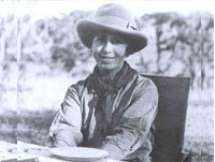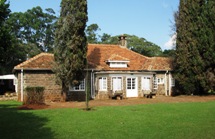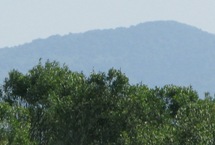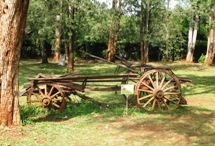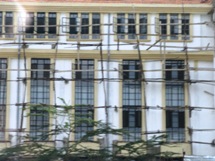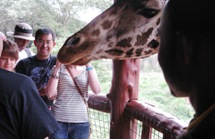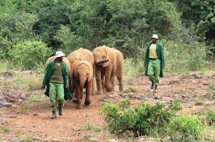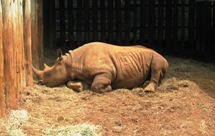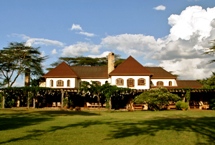Kenya : Day TwentyFour : Nairobi
Although there are some tourist attractions in most African capital cities, such as Lusaka, or Dar es Salaam, they don't really justify a deliberate overnight stay. Nairobi is quite different in this respect: as we have already seen it has its own National Park, replete with game, and today we are targeting its Karen Blixen Museum, Giraffe Centre and the Daphne Sheldrick Elephant Orphanage.
Karen Blixen (![]() ), also known by her pen name Isak Dinesen , is of course the author of the iconic narrative, 'Out Of Africa', later made into an Oscar-winning film starring Robert Redford and Meryl Streep. Her home in Nairobi was a remote farmhouse some 10 km from the city centre, at the foot of the Ngong Hills.
), also known by her pen name Isak Dinesen , is of course the author of the iconic narrative, 'Out Of Africa', later made into an Oscar-winning film starring Robert Redford and Meryl Streep. Her home in Nairobi was a remote farmhouse some 10 km from the city centre, at the foot of the Ngong Hills.
Inevitably, the farmhouse has now become part of Nairobi's city sprawl, and now serves as the Karen Blixen Museum (![]() ), a very popular tourist spot. However the Ngong Hills are still visible from its grounds (
), a very popular tourist spot. However the Ngong Hills are still visible from its grounds (![]() ).
).
The house's interior (![]() ), (
), (![]() ), below, is interesting in the sense that, apparently, half the furniture and furnishings are Karen Blixen's own, the remainder being brought in, and left here, when the house served as the set for the Out of Africa film. I certainly couldn't tell which was which. The gardens surrounding the house itself are delightful in their own right, with several relics of this time almost a century ago (
), below, is interesting in the sense that, apparently, half the furniture and furnishings are Karen Blixen's own, the remainder being brought in, and left here, when the house served as the set for the Out of Africa film. I certainly couldn't tell which was which. The gardens surrounding the house itself are delightful in their own right, with several relics of this time almost a century ago (![]() ), opposite.
), opposite.
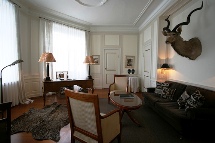
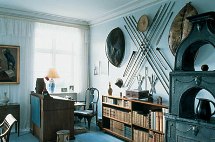
After an interesting hour or so spent here we travelled a short distance across Nairobi to its Giraffe Centre, passing along the way an example of Africa's version of steel scaffolding - made entirely out of bamboo (![]() ).
).
The Giraffe Centre (![]() ) was established as a tourist destination in 1983, although originally established simply in order to protect the endangered Rothschild giraffe. The giraffe can be observed within their own protected compound, although the main attraction for visitors is feeding the giraffes from a raised observation platform, (
) was established as a tourist destination in 1983, although originally established simply in order to protect the endangered Rothschild giraffe. The giraffe can be observed within their own protected compound, although the main attraction for visitors is feeding the giraffes from a raised observation platform, (![]() ), (
), (![]() ), below, the giraffes sticking their heads inside (
), below, the giraffes sticking their heads inside (![]() ), opposite. Then, as can be seen from the lower photograph (
), opposite. Then, as can be seen from the lower photograph (![]() ), opposite, the idea is to deposit the food (supplied) directly onto the giraffe's tongue.
), opposite, the idea is to deposit the food (supplied) directly onto the giraffe's tongue.
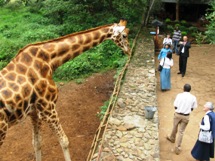
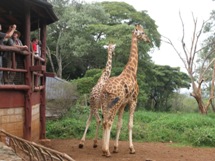
However, as the picture (![]() ), below left, shows, the giraffe can also be persuaded to lick it directly off your face, although I myself preferred to use the conventional method(
), below left, shows, the giraffe can also be persuaded to lick it directly off your face, although I myself preferred to use the conventional method(![]() ), below right. The little girl watching from below appears rather more comfortable with this approach! The Centre's grounds also contain a craft centre for souvenirs (
), below right. The little girl watching from below appears rather more comfortable with this approach! The Centre's grounds also contain a craft centre for souvenirs (![]() ).
).
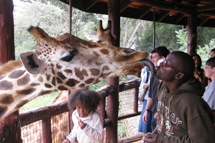
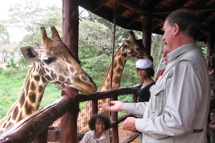
The David Sheldrick Wildlife Trust, now run by his widow, Daphne, embraces all measures that compliment the conservation, preservation and protection of wildlife, but with its main emphasis placed upon the rescuing and hand-rearing of orphaned elephants. At feeding time the elephants are led in from the main area of the sanctuary by their keepers (![]() ), opposite. Here they are fed (
), opposite. Here they are fed (![]() ) below left, and enjoy games such as football (
) below left, and enjoy games such as football (![]() ) below right. The centre also serves as a rhino sanctuary (
) below right. The centre also serves as a rhino sanctuary (![]() ).
).
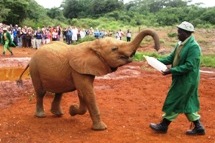

After what had been a very interesting conclusion to our Kenya visit, we moved on to our final night's resting place, the Hogmead Hotel (![]() ). The Hogmead is more like a very luxurious safari lodge than a conventional city centre hotel, and is situated very conveniently for the airport. They also provide day rooms for people needing somewhere to rest, shower and change between flights.
). The Hogmead is more like a very luxurious safari lodge than a conventional city centre hotel, and is situated very conveniently for the airport. They also provide day rooms for people needing somewhere to rest, shower and change between flights.
| Back to previous page (Day 23) | Forward to next page (Day 25) |
